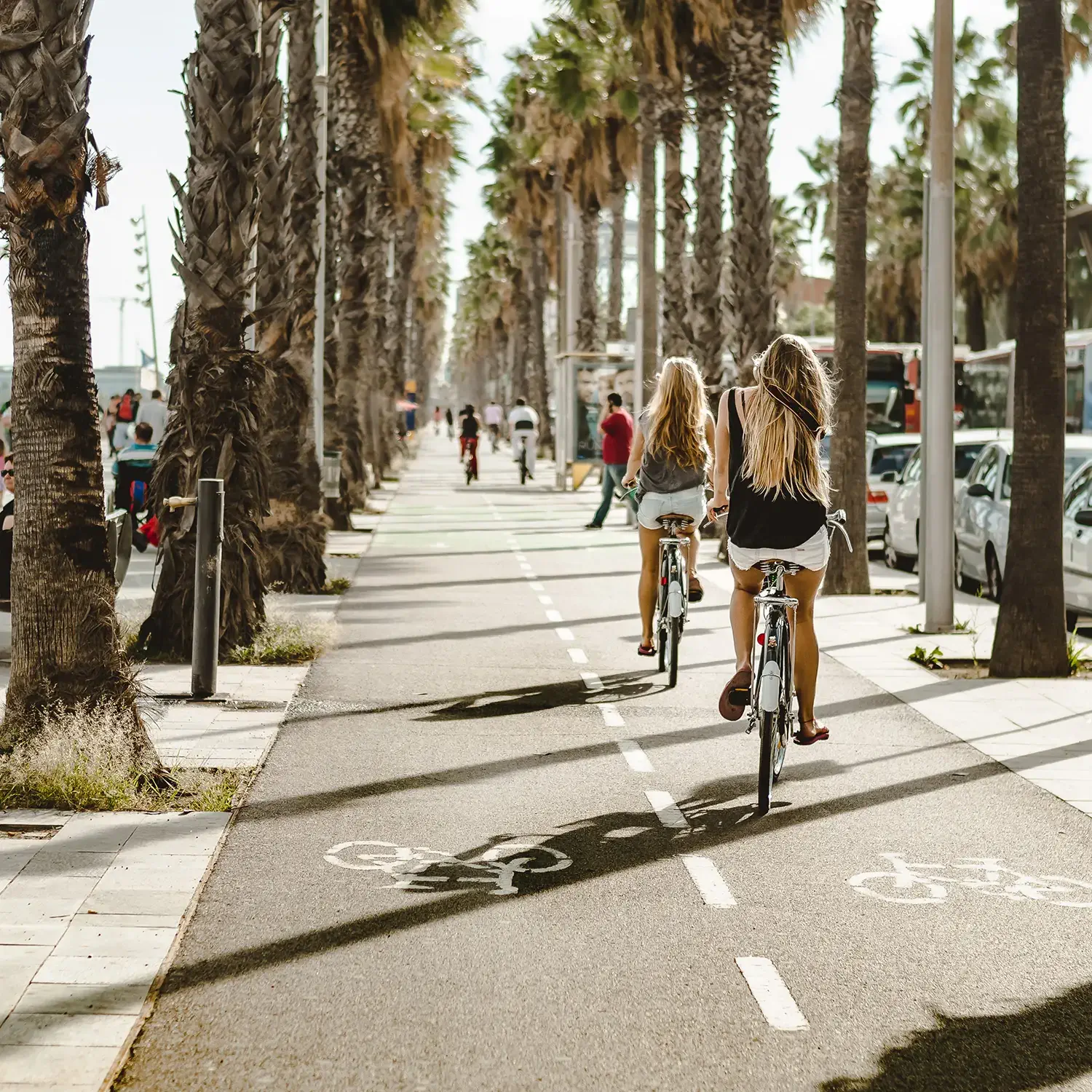Located between sea and mountains, Barcelona is famous for its mix of Gothic and modern architecture. Here are our picks for the top 9 stunning architectural sights in the Catalan capital, hand-picked from our free city guide for Barcelona, momondo places, for iPhones.
Monestir de Pedralbes
Pure Gothic architecture at Monestir de Pedralbes
A cobbled lane leads up to the sublime Monestir de Pedralbes, established in 1326 by Queen Elisenda, as a convent for blue-blooded nuns. The complex, one of the finest examples of Catalan Gothic design, is now a museum; the small community of Poor Clare nuns has moved to an adjoining building.
The convent is set around a serene three-story cloister dotted with trees and fountains and filled with the sound of birdsong. The former refectory, prayer cells and other rooms are now filled with objects outlining the history of the convent. Among them is the pale marble tomb of Queen Elisenda located in the convent’s beautiful single-nave church.
Where: Baixada del Monestir 9
Nearest station: Reina Elisenda
Gran Teatre del Liceu
Grandiose and lavish: detail of the gilded ceiling in the auditorium of the Gran Teatre del Liceu
Barcelona’s opera house has been the location of real life events as dramatic as the scenes that have been acted out on its stage over the years.
Built in the late 19th century, the Gran Teatre has a tumultuous history, including two fires, the second one ravaging the building in 1994.
The Liceu was rebuilt, even larger than before, with heavy lashings of marble, gilt and plush red velvet added. Tickets for shows are in the upper price range, but you can opt for a tour of the building to get a taste of its grandeur and significance.
Where: La Rambla 51-59
Nearest station: Liceu
Casa Batlló and Casa Amatller
Right next to each other, Casa Amatller and Casa Batlló are reminiscient of a fairy-tale world
One street of the Eixample contains two magnificent mansions from the Modernista period: Casa Amatller and Casa Batlló.
Casa Amatller and its stepped rooftop studded with candy-like ceramic work was designed by Josep Puig i Cadafalch for the chocolate baron Antoni Amatller at the turn of the 20th century. Puig i Cadafalch transformed the formerly unremarkable mansion into a fairy-tale castle set around a Gothic courtyard. Look closely at the pseudo-medieval creatures on the facade: perhaps you’ll spot the camera-wielding rat, or the monkey grinding cocoa beans.
Gaudí fans will delight in the Casa Batlló with its whipped-cream ceilings, swirling fireplaces and delicate wrought-iron balconies. Gaudí was an avowed enemy of the straight line, and you won’t find a single one anywhere in this building. Built in 1906, it is widely believed that the facade represents the story of Saint Jordi’s fight with a dragon. The strange, bone-like pillars supporting the balconies are the bones of the dragon’s prey, and the undulating roof is its scaly back, while the bulbous cross protruding from the top of the building symbolises Saint Jordi’s lance.
Where: Passeig de Gràcia 41-43
Nearest station: Passeig de Gràcia
Park Güell
Park Güell: part fairy-tale wonderland, part city parkland
Inspired by 19th century English ‘garden cities’, an expansive piece of land in the Collserola foothills was chosen as the site of Park Güell, and architect Antoni Gaudí was invited to construct the communal spaces.
A pair of his fairy-tale pavilions flanks the main entrance. A flight of brightly tiled stairs sweeps up past the emblematic salamander statue to the Hypostyle Hall filled with almost a hundred shimmering columns. The main square, with its long, undulating bench richly covered in yet more trencadís tiles, offers spectacular views of the entire city and the sea.
The park has suffered through the sheer number of visitors and an admission fee was recently introduced. This only affects the swathe of the park with Gaudí’s interventions; the rest of the bushy parkland can be wandered at will.
Where: Carrer d’Olot s/n
Nearest station: Vallcarca
Buildings at Plaça Sant Just
Fivaller Fountain reigns as one of Barcelona’s oldest medieval water fountains
The tiny Plaça Sant Just is a charming square nestled in a maze of streets and distinguished buildings in the Gothic Quarter. These include the Moxó and Requesens palaces and the 14th century Sants Just i Pastor church. It’s well worth popping in to admire the church’s Byzantine baptismal fonts and on your way out have a look at the Gothic-style Fivaller Fountain, featuring three medieval faces.
The palaces offer guided tours and the church is open weekdays from 11am–2pm.
Where: Plaça Sant Just
Nearest station: Jaume I
La Pedrera – Casa Milà
Once heavily criticised, La Pedrera features Gaudí’s signature wavy lines and fantastical shapes
Dazzled by Antoni Gaudí’s work on Casa Batlló, wealthy entrepreneur Pere Milà commissioned the architect to create a new apartment building on the Passeig de Gràcia.
The creamy undulations of the resulting Casa Milà were unlike anything anyone had ever seen before – and for many, in a bad way. It was lambasted by critics, who dubbed it La Pedrera – the stone quarry. The name stuck, but a century later, the building is considered a masterpiece.
Owned by a local bank, La Pedrera now contains exhibition spaces, a concert hall and a fascinating model apartment – El Pis de la Pedrera, restored to look just as it did in 1911. The Espai Gaudí room in the attic provides an overview of Gaudí’s life and works and gives access to the undulating roof terrace.
Where: Carrer de Provença 261-265
Nearest station: Diagonal
Sagrada Família
Gaudí’s unfinished masterpiece, La Sagrada Familia, sits high in Barcelona’s landscape
The enormous Temple Expiatori de la Sagrada Família, which dominates the city’s skyline, is Gaudí’s masterpiece, although it has polarized opinions ever since its inception over a century ago.
The young Gaudí joined the project in 1883 and grew increasingly obsessed. After 1914, he worked on nothing else and spent his last years living in a shack on the building site. At the time of his death in 1926, only the Nativity Facade was complete – a joyful, exuberant eruption of organic forms.
The work has continued and eight of the planned 18 towers are complete. Although the work is not expected to be finished before 2026, a century after Gaudí’s death, the completion of the central nave allowed the temple to be consecrated by Pope Benedict XVI in late 2010.
Where: Carrer de Mallorca 401
Nearest station: Sagrada Família
Catedral Basílica Metropolitana de Barcelona
Sparse in decoration, the Catedral de Barcelona is a great example of Catalan Gothic architecture
Barcelona’s impressive cathedral is the focal point of the Barri Gòtic. It presides over a vast square that was once the location of a Roman temple, and its spires soar above the immediate cityscape.
Built between the 13th and 15th centuries, the Gothic style cathedral has three aisles, 29 side chapels, intricately carved choir stalls and many rich treasures, including the beautiful alabaster tomb of Santa Eulália, the city’s patron saint, who is said to have met her fate by impalement in the nearby Baixada de Santa Eulália. The most crowd-pleasing element of the cathedral tends to be the cloister, a charming palm tree-filled refuge inhabited by a gaggle of 13 geese in tribute to the saint.
Tip: the cathedral is free to enter in the morning or early evening.
Where: Pla de la Seu 3
Nearest station: Jaume I
Torre Agbar
Torre Agbar dominates Barcelona’s skyline, especially at night © jikatu
The Torre Agbar, designed by French architect Jean Nouvel and completed in 2005, is a slender, conical building that has become a symbol of the contemporary city. It stands 465 feet tall, making it the third tallest building in Barcelona.
The tower was built as the HQ of the municipal water company, and Nouvel likened it to a spouting geyser. In late 2013, it was announced that a hotel group had bought the building, meaning that in the near future the interior will have open access.
During the day, its colorful facade evokes the trencadís tiles used by Gaudí and the Modernistas, but at night, shades of red, blue, and purple ripple across the exterior thanks to more than 4,500 LED lights incorporated into the tower’s skin.
Where: Avinguda Diagonal 211
Nearest station: Glòries



